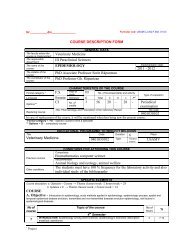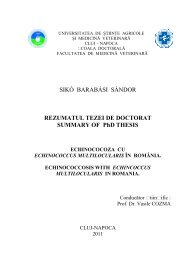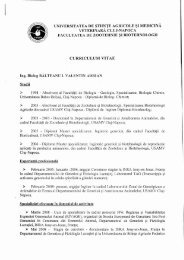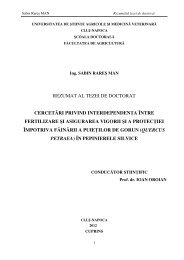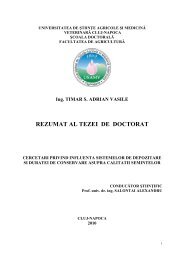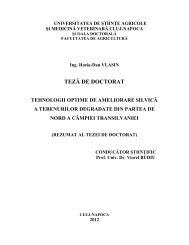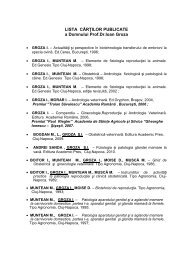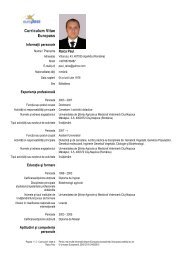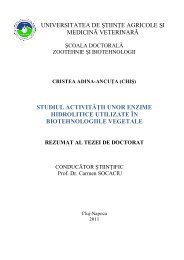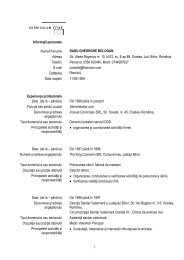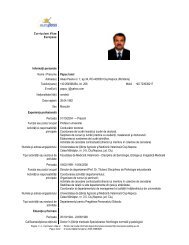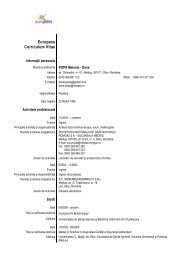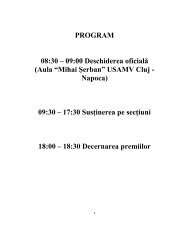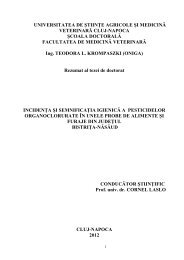Eng. SÎRBU CAMELIA MARIA (ALĂMOREAN) Ph D THESIS ...
Eng. SÎRBU CAMELIA MARIA (ALĂMOREAN) Ph D THESIS ...
Eng. SÎRBU CAMELIA MARIA (ALĂMOREAN) Ph D THESIS ...
You also want an ePaper? Increase the reach of your titles
YUMPU automatically turns print PDFs into web optimized ePapers that Google loves.
UNIVERSITY OF AGRICULTURAL SCIENCES AND<br />
VETERINARY MEDICINE<br />
CLUJ -NAPOCA<br />
AGRICULTURE FACULTY<br />
<strong>Eng</strong>. <strong>SÎRBU</strong> <strong>CAMELIA</strong> <strong>MARIA</strong> (<strong>ALĂMOREAN</strong>)<br />
<strong>Ph</strong> D <strong>THESIS</strong><br />
ABSTRACT<br />
RESEARCH REGARDING POTATO<br />
CULTIVATION IN THE BIOLOGICAL<br />
(ORGANIC) AGRICULTURE SYSTEM<br />
SCIENTIFIC COORDINATOR<br />
Univ.prof. dr. eng. GAVRILĂ MORAR<br />
CLUJ-NAPOCA<br />
2011
Ing. Camelia Maria Sîrbu (Alămorean) Abstract<br />
INTRODUCTION<br />
The potato, with a long and glorious history, is originally from Central and South<br />
America, where, along with corn, was one of the staple crops, which fed and sustained a<br />
thriving civilization and a stunning indigenous culture and assured the greatness of the<br />
Inca Empire. After the discovering of ”The New World” in the years 1492-1496, the<br />
potato arrived in the ”old Europe” around the year 1553, as an unknown plant, and later,<br />
managed to conquer the entire civilization.<br />
Besides wheat, maize and rice crops, the potato is widespread worldwide. The<br />
potato became a staple food for nearly all mankind, being used and appreciated not only<br />
in poor countries and areas in Asia, Africa and Latin America but also in rich and<br />
developed countries such as <strong>Eng</strong>land, Holland, Germany, France U.S. and others<br />
(IANOSI I.S., 2002).<br />
Under the auspices of large international organizations such as UN or FAO, on<br />
December 22nd , 2005, the year 2008 was declared International Year of the Potato, and<br />
the importance of the potato in the world economics is also shown by the fact that this<br />
plant is the only agricultural crop traded at the Stock Exchange on Wall Street in New<br />
York.<br />
The potato is a crop with high production potential, an equivalent area being able<br />
to produce 10-15 times more food than wheat, corn or rice.<br />
Due to the high nutritional value of potato tubers caused by the balanced content<br />
of carbohydrates, protein, fat and vitamins, to their taste and high digestibility, the potato<br />
satisfies most tastes and most diverse requirements.<br />
The potato tuber is an almost complete food, with a high content of carbohydrates<br />
(15-25%, depending on variety), protein substances and vitamins (A1, B1, B2, B3, K and<br />
especially vitamin C, which summarizes 13-23 mg/100 g dry matter), and minerals (100<br />
grams boiled tubers contain 0.5 to 2 mg assimilable iron, assimilable phosphorus 25-50<br />
mg and 6-17 mg assimilable calcium) (WIRTHS, 1968 cited by DRAICA C . et al.<br />
1996).<br />
For industry, the potato is used in producing alcohol, starch and glucose. From<br />
1000 kg of potatoes one can get 56-132 litres of alcohol or 140 kg of starch, or 240-260<br />
kg of chips, or 700-750 kg of pommes-frites. Starch can be used for producing more than<br />
1
Ing. Camelia Maria Sîrbu (Alămorean) Abstract<br />
700 derivatives that be used in the food, pharmaceutical, textile industries, paper<br />
production, etc. (DRAICA C., 1995).<br />
Also, the potato is used to produce bioethanol which, blended with gasoline, is<br />
considered to be the fuel of the 21st century. Starting with 2017, the European Union<br />
plans to subsidize 50% of the petrol refineries that use a mixture of gasoline and bio-<br />
ethanol made of potato or other plants such as beets and maize (http://www.zdd.ro ).<br />
For animals, the potato is considered valuable fodder, providing 26-30 UN/100g<br />
respectively 0.64 to 1.50digestible protein/ 100g. A quantity of 4 kg boiled potato is<br />
equivalent to 1 kg of barley, 0.9 kg of corn or 12 litres of whey (Ianosi IS, 2002).<br />
In agronomic terms, the potato fits very well in grain or vegetable rotation crops,<br />
which need mandatorily, as part of the rotation system, a plant which develops its yield in<br />
the soil, which breaks up the soil this way and improves its physical, chemical and<br />
biological characteristics by its own growth and development in the soil .<br />
The coordination of this scientific research, the interpretation of results and the<br />
drafting of this paper were conducted under the direction of the distinguished university<br />
professor <strong>Ph</strong>D Morar Gavrila. To him I address my most sincere gratitude and thanks for<br />
the support granted to my permanent professional and moral development.<br />
I express my gratitude and sincere thanks to <strong>Ph</strong>D professor engineer Ion Oltean for<br />
his support in the establishment and completion of the Colorado beetle control<br />
experiments.<br />
I have to address my words of thanks and consideration to the team of the<br />
<strong>Ph</strong>ytotechny Department for their support during the preparation of the thesis.<br />
I also want to thank my family for the dedication and support throughout the<br />
preparation of this work.<br />
2
Ing. Camelia Maria Sîrbu (Alămorean) Abstract<br />
CHAPTER I<br />
THE CONCEPT OF BIOLOGICAL (ORGANIC) AGRICULTURE AND ITS<br />
EVOLUTION<br />
Chapter I presents the causes that led to the emergence and spreading of the<br />
concept of biological (organic) agriculture in Europe and worldwide, the concept of<br />
organic agriculture and the situation of organic farming in the world and in Romania.<br />
CHAPTER II<br />
THE CURRENT STAGE OF RESEARCH ON ORGANIC POTATO<br />
PRODUCTION SYSTEM<br />
The chapter presents the current stage in the research on the biological potato<br />
production system and describes the potato cultivation technology in this system of<br />
agriculture (conversion of land, location of the potato crop, crop rotation and soil tillage,<br />
soil preparation for planting and potato planting, fertilization and maintenance works,<br />
harvesting and storage of the potato yield).<br />
CHAPTER III<br />
RESEARCH OBJECTIVES, MATERIAL AND METHOD<br />
3.1. RESEARCH OBJECTIVES<br />
The research objectives were:<br />
� The study of a range of potato varieties suitable to organic farming, and<br />
which should be characterized by:<br />
- genetic resistance to major potato diseases;<br />
- resistance to degeneration, known resistance to major potato viruses;<br />
- a reasonable production potential, able to ensure economic efficiency;<br />
- accepted by consumers.<br />
� Identification of natural fertilizers applied at the soil or foliage level to help<br />
stimulate the photosynthetic efficiency and production;<br />
� Identification and testing of natural products to control pests and diseases or<br />
other natural control products accepted in organic farming;<br />
� Control of weeds through various means other than chemical<br />
3
Ing. Camelia Maria Sîrbu (Alămorean) Abstract<br />
3.2. MATERIAL AND RESEARCH METHOD<br />
3.2.1. Biological material used<br />
For studying the suitability of potato varieties to organic farming, an assortment of<br />
11 varieties were considered, varieties that had been created at the Romanian National<br />
Institute of Research and Development for Potato and Sugar Beet, Brasov or at other<br />
research stations around the country, such as those in Targu Secuiesc and Miercurea<br />
Ciuc; two varieties were of Dutch origin.<br />
These cultivars were as follows: Roclas, Zamolxis(Dacia), Cumidava(Amelia),<br />
Christian, Redsec, Productiv, Tentant, Frumoasa, Robusta, Rozal, Sante, Riviera and<br />
Agata<br />
3.2.2. Materials used in research<br />
3.2.2.1. Foliar fertilizers<br />
Of all the foliar fertilizers allowed in organic farming, the following products were<br />
used, in concentrations recommended by the producing companies: Biome PLUSS,<br />
Biostar, Maxiroot, Terra Sorb, Glutaxin. The foliar fertilizers were applied at full plant<br />
growth (June, July, August), 3 times each year.<br />
3.2.2.2. Potato blight control<br />
For the potato blight control, nine natural products were tested in 2004, and 7in<br />
the next year; all products are allowed in organic farming.<br />
The treatments were applied at full plant growth, twice in 2004 and 3 times in the<br />
following year.<br />
The treatments with natural products allowed in organic farming demonstrate the<br />
possibility to extend the foliage vegetation period beyond the natural resistance limit of<br />
the variety. The products we used were: nutritive clay, whey, Bordeaux mixture,<br />
bentonite, copper oxychloride, milk without fat, copper hydroxide, clay, potassium<br />
permanganate.<br />
4
Ing. Camelia Maria Sîrbu (Alămorean) Abstract<br />
3.2.2.3. Colorado potato beetle control<br />
In 2004, in the experimental field of the <strong>Ph</strong>ytotechny Department, located on the<br />
Cojocna farm, two natural extracts were tested, namely those obtained from Taraxacum<br />
officinale L (dandelion) and Tagetes erecta L, with a view to analysing their repellent<br />
effect upon the adults belonging to the Leptinotarsa decemlineata Say species.<br />
For the extract obtained from Tagetes erecta L., we used powder of flowers and<br />
receptacles in a percentage of 20% active ingredients with the following solvents:<br />
propylene glycol, ethanol, ethyl acetate and water with a ratio of 1: 0.15: 0.5: 8 .<br />
For the second extract, the one from Taraxacum officinale L, we used a tincture<br />
made of fresh leaves with 20% active ingredients, and, as solvents, propylene glycol and<br />
water with a ratio of 1: 1.<br />
To test the repellent effect of these extracts, they were tested either separately<br />
(checking two concentrations for each extract) or mixed (checking two mixtures with<br />
different amounts of extract).<br />
The Solo 4 Pump was used for the treatment, applying a normal volume of<br />
solution (800 litres solution / ha), so that the applied solution would ensure full coverage<br />
of the foliar system. The effectiveness was assessed by counting the egg deposits for each<br />
variant and reporting the number to the number of treated plants. Efficacy was calculated<br />
using the following formula: E% = (1-n / N) x 100 where n = average number of egg<br />
deposits / treated and N = average number of egg deposits/control plants (no treatment).<br />
Also in 2004, different hydro-alcoholic extracts were tested in Colorado beetle<br />
larvae control. In obtaining the extracts 12 species of plants were used:<br />
� Armoracia rusticana Lam.<br />
� Artemisia abrotanum L.<br />
� Artemisia capilaris, Artemisia absinthium L.<br />
� Chrysanthemum cinerariaefolium Trev.<br />
� Chrysanthemum balsamita var. canfora,<br />
� Leuzea carth.<br />
� Marrubium vulgaris L.<br />
� Mentha piperita L.<br />
� Nepeta cataria var. citriodora<br />
5
Ing. Camelia Maria Sîrbu (Alămorean) Abstract<br />
� Ruta corsica L.<br />
� Taraxacum officinale L.;<br />
� Tagetes erecta L.<br />
For the extracts obtained from Tagetes erecta L., tested in 4 variants, we used<br />
powder of flowers and receptacles in a percentage of 20% active ingredients with the<br />
following solvents: propylene glycol, ethanol, ethyl acetate and water with a ratio of 1:<br />
0.15: 0.5: 8 .<br />
In other 4 variants we used an extract of fresh leaves of Taraxacum officinale<br />
L.,20% active ingredients, and as solvents, : propylene glycol and water, with a ratio of<br />
1 : 1.<br />
For 2 variants we used an extract of fresh leaves of Tagetes erecta, and as<br />
solvents, propylene glycol and water, with a ratio of 1 : 1.<br />
For other 20 variants, the extracts were made of herba (for each species), in a<br />
mixture of propylene glycol and water, with a ratio of 1 : 1.<br />
To assess the efficacy, the same method of calculation was applied, as the one<br />
used for repellents.<br />
In 2005 there were seven variants of vegetal extracts tested to determine their<br />
effectiveness on larvae of Colorado beetle. These were:<br />
V1 – extract of Armoracia rusticana , ratio 1:3<br />
V2- extract of Chysanthemum cinerariaefolium , ratio 1:3<br />
V3 - extract ofArtemisia abrotanum, ratio 1:3<br />
V4 - extract of Artemisia capilaris, ratio 1:3<br />
V5 - extract of Chysanthemum balsamita var. canfora, ratio 1:3<br />
V6 - extract of Marrubium vulgaris, ratio 1:3<br />
V7 - extract of Ruta corsica , ratio 1:3<br />
For further studies of Coloroado beetle control, a lab experiment was established<br />
for testing the three extracts of the most effective products on larvae of different ages.<br />
The extracts used were as follows:<br />
Extract 1 – Artemisia abrothanum – 9% in ethanol 20%<br />
Extract 2 – Chrysanthemum cinerariaefolium - 9% in ethanol 20%<br />
Extract 3 – Chrysanthemum balsamita - 9% in ethanol 20%<br />
6
Ing. Camelia Maria Sîrbu (Alămorean) Abstract<br />
Extract 4 – Armoracia rusticana<br />
3.2.3. Research methods<br />
a) The influence of foliar fertilizers and biological products used to control blight on<br />
potato yields in varieties suitable for organic farming<br />
In 2004, foliar fertilizers were applied to the 12 varieties. Also all natural products<br />
tested for blight control were applied to the 12 varieties.<br />
In 2006, 2007, 2008 we initiated systematic trifactorial research on the interaction<br />
between variety, various blight control products and foliar fertilizers respectively.<br />
Experiments have been located and calculated by the method of subdivided trials with 2<br />
and 3 factors, in four repetitions.<br />
Experiment 1. – The influence of foliar fertilizer on the yield in potato varieties<br />
suitable for organic farming with the following factors and graduations:<br />
Factor A- Experimental year, with three graduations:<br />
a1 - 2006<br />
a2 – 2007<br />
a3 - 2008<br />
Factor B – Potato cultivar suitable for organic farming, with five graduations:<br />
b1 – Robusta<br />
b2 – Rozal<br />
b3 – Redsec<br />
b4 – Amelia<br />
b5 - Productiv<br />
Factor C – Foliar fertilization, with six graduations<br />
c1 – no fertilizer<br />
c2 – Biomit pluss<br />
c3 – Biostar<br />
c4 – Maxiroot<br />
c5 – Terra Sorb<br />
c6 – Glutaxin<br />
7
Ing. Camelia Maria Sîrbu (Alămorean) Abstract<br />
Experiment 2. – Blight control using biological products, with the following factors<br />
and graduations:<br />
Factor A – Potato cultivar suitable for organic farming, with five graduations:<br />
a1 – Robusta<br />
a2 – Rozal<br />
a3 – Redsec<br />
a4 – Amelia<br />
a5 - Productiv<br />
Factor B – Alternative products for blight control, with eight graduations:<br />
b1- no tratament<br />
b2 – Bordeaux mixture<br />
b3 – clay<br />
b4 – bentonite<br />
b5 – copper oxy-chloride<br />
b6 – copper hydroxide<br />
b7 – nutritive clay<br />
b8 – potassium permanganate<br />
The experiments were placed in 4 repetitions rigorously respecting the potato<br />
cultivation technology to highlight the experimental factors l.<br />
Blight resistance was assessed by the degree of attack of the disease on the foliage,<br />
given by the relationship between the attack intensity and the frequency of the disease.<br />
The assessment of the resistance of potato varieties to blight was done by hand marks<br />
from 1 to 9 (score 1 - very resistant to blight attack and score 9 - very sensitive).<br />
b) Weed control<br />
Out of the usual methods for weed control in organic farming, we chose to use fire.<br />
The reason was the emergence of weeds in the potato crop before the emergence of the<br />
plants, when the fire can act over the entire surface; after the emergence of potato plants,<br />
they can be protected with special shields, and the fire will be conducted among them .<br />
8
Ing. Camelia Maria Sîrbu (Alămorean) Abstract<br />
Fig. 6. Weed control(original)<br />
We used a special tool made in the workshops of the university, designed by our<br />
team, and consisting of a cart on bicycle wheels that can move around the field directing<br />
a jet of gas from a tank located on the trolley. Weeds were observed and destroyed at<br />
various stages of development and the fire was controlled by adjusting the jet to cover the<br />
surface between the potato plants (Fig. 6)..<br />
9
Ing. Camelia Maria Sîrbu (Alămorean) Abstract<br />
CHAPTER IV<br />
SOIL AND CLIMATIC CONDITIONS UNDER WHICH EXPERIENCES<br />
WERE CARRIED OUT<br />
4.1. EXPERIMENTS LOCATION<br />
Over the years, experiments have been conducted in several locations: in 2004 in<br />
the experimental fields of USAMV Cluj-Napoca from Cojocna farm, and the in the<br />
experimental years 2006-2008 at the Research Station for the Culture and Development<br />
of Pastures- Jucu.<br />
Subsections 4.2, 4.3. and 4.4.present the soil and climatic conditions in which the<br />
experiments were conducted.<br />
CHAPTER V<br />
RESULTS<br />
5.1. RESULTS REGARDING THE SUITABILITY OF THE STUDIED CULTIVAR<br />
ASSORTMENT TO BIOLOGICAL AGRICULTURE<br />
5.1.1. The results regarding the suitability of a potato cultivar assortment to<br />
biological agriculture, in 2004, in Cojocna, Cluj county<br />
The main features studied for the varieties considered in this research were: total<br />
yield, the average weight of a tuber, the average number of tubers in a nest and the<br />
resistance to blight. In the first year (2004) a number of 12 varieties of potato were<br />
studied.<br />
The Romanian varieties most suitable for organic farming, in the experimental<br />
year 2004, were Robusta, Redsec, Rozalia and Amelia, which gave high yields and had a<br />
good resistance to blight. The Amelia cultivar did not score very high in what the yield is<br />
concerned, but proved to be highly resistant to blight attack, which is a particularly<br />
important feature in organic farming (Table 1)..<br />
10
Ing. Camelia Maria Sîrbu (Alămorean) Abstract<br />
Table 1.<br />
Results of tests on the suitability of potato cultivars in organic farming (Cojocna<br />
Cultivar Yield<br />
t/ha<br />
Average<br />
weight<br />
of a<br />
tuber<br />
(g)<br />
2004)<br />
Average<br />
No. of<br />
tubers/nest<br />
03.08.2004<br />
Degree of<br />
attack<br />
(%)<br />
01.09.2004<br />
Degree of<br />
attack<br />
(%)<br />
10.09.2004<br />
Degree of<br />
attack<br />
(%)<br />
Sante 36,4 45,9 17 10 30 80<br />
Tentant 34 58,1 14 60 90 90<br />
Robusta 28,5 54,0 11 10 10 70<br />
Redsec 24,6 51,3 10 10 70 80<br />
Frumoasa 24,4 52,4 10 50 90 90<br />
Rozal 21,7 57,4 8 10 30 80<br />
Roclas 17,6 50,3 7 80 90 90<br />
Agatha 17,2 54,2 7 90 90 90<br />
Amelia 16,7 49,6 7 10 30 80<br />
Dacia 13,2 34,3 8 20 90 90<br />
Christian 9,5 24,1 8 40 90 90<br />
Riviera 8,8 41,4 5 90 90 90<br />
10-30% – blight rezistant; 40-60% – blight rezistant; 60-90% – blight rezistant;<br />
5.1.5. The results regarding the suitability of a local potato cultivar assortment to<br />
biological agriculture, the average of years 2006-2008<br />
Experimental years 2006-2007-2008 were close in terms of friendliness to potato<br />
crops and similar from the climatic point of view. The obtained yields are similar<br />
between the three experimental years (Table 2), oscillating around 35-36 t / ha, with<br />
insignificant yield differences.<br />
The influence of experimental years on yield<br />
Table 2<br />
Year Yield(t/ha) % Difference Significance Duncan Test<br />
1. 2006 35,55 100,0 0.00 Mt. A<br />
2. 2007 35,56 100,0 0,01 - A<br />
3. 2008 34,68 97,5 -87 - A<br />
DL(p 5%) 1,47<br />
DL(p 1%) 2,23<br />
DL(p 0,1%) 3,58<br />
As an average over the three experimental years, the tested potato cultivars (Table<br />
3). can be grouped into two categories: the first category, represented by Robusta and<br />
11
Ing. Camelia Maria Sîrbu (Alămorean) Abstract<br />
Rozal cultivars, are varieties with less potential for high yields but more suitable to<br />
organic farming as a result of their higher resistance to blight, and the second category<br />
comprising the varieties with higher production potential (Redsec, Amelia and<br />
Productiv), which in the experimental years have exceeded the Robusta cultivar,<br />
considered as a control, by13 to 20% . These cultivars - Redsec, Amelia and Productiv<br />
gave significantly higher yields, over the three years, as compared with the Robusta<br />
variety, the differences being validated by statistical calculation performed through the<br />
multiple comparison test (Duncan).<br />
Table 3.<br />
The behaviour of the potato cultivars in the three experimental years<br />
Cultivar Yield(t/ha) % Difference Significance Duncan Test<br />
1. Robusta 32,20 100,0 0.00 Mt. A<br />
2. Rozal 31,48 97,8 -0,71 - A<br />
3. Redesec 38,63 120,0 6,44 *** B<br />
4. Amelia 36,57 113,6 4,38 *** B<br />
5. Productiv 37,44 116,3 5,25 *** B<br />
DL(p 5%) 2,15<br />
DL(p 1%) 2,88<br />
DL(p 0,1%) 3,80<br />
In the interaction experimental year x variety suitable to organic farming there are<br />
a variety of different behaviours of the cultivars over the experimental years (Table 4).<br />
Whereas in 2006 the varieties were almost equal to each other from the point of view of<br />
their yields, except for the Rozal cultivar which had a very strong decrease expressed by<br />
significant negative differences, in 2007 and 2008 all cultivars exceeded the variety<br />
Robusta , which was considered as a control. There seems to be an inverse correlation,<br />
which also occurs in the case of other crops such as wheat, corn, beets, etc., between<br />
production and quality. While the Robusta cultivar proved to be the most suitable variety<br />
for organic farming in terms of resistance to blight, its yields were lower than the other<br />
tested cultivars, considering the mean of the three years.<br />
12
Ing. Camelia Maria Sîrbu (Alămorean) Abstract<br />
Tuber production in the interaction experimental year x cultivar<br />
Year Cultivar Yield<br />
(t/ha)<br />
% Difference<br />
(t)<br />
Significance Duncan<br />
Test<br />
2006 Robusta 36,91 100,0 0,00 Mt. DEF<br />
Rozal 28,14 76,2 -8,78 000 A<br />
Redsec 37,85 102,6 0,94 - EF<br />
Amelia 37,29 101,0 0,38 - EF<br />
Productiv 37,58 101,8 0,66 - EF<br />
2007 Robusta 30,10 100,0 0,00 Mt. AB<br />
Rozal 31,54 104,8 1,44 - ABC<br />
Redsec 38,19 126,9 8,09 *** EF<br />
Amelia 39,53 131,3 9,43 *** F<br />
Productiv 38,44 127,7 8,33 *** EF<br />
2008 Robusta 29,57 100,0 0,00 Mt. AB<br />
Rozal 34,77 117,6 5,20 ** CDE<br />
Redsec 39,85 134,8 10,28 *** F<br />
Amelia 32,90 111,3 3,33 - BCD<br />
Productiv 36,31 122,8 6,74 *** DEF<br />
DL (p 5%) 3,73<br />
DL (p 1%) 5,00<br />
DL (p 0,1%) 6,59<br />
5.2. 1 RESULTS ON THE EFFECTIVENESS OF NATURAL FOLIAR<br />
FERTILIZERS ON THE YIELD OF POTATO CULTIVARS<br />
Table 4.<br />
5.2.1 Results on the effectiveness of natural foliar fertilizers on the yield of potato<br />
cultivars, in 2004, in Cojocna, Cluj county<br />
. The way in which the foliar fertilizers influenced the yield of the year 2004 is<br />
shown in Table 5.<br />
Unfertilized cultivars reacted differently, by variable production increases, to<br />
foliar fertilizer application, and some even had a production decrease, most likely<br />
because of a metabolic block in the synthesis of starch, which is the case of the Sante<br />
cultivar, which reacted negatively to most foliar fertilization variants . Other varieties<br />
reacted positively to all products, such as Rozal, Dacia, Amelia, Riviera and Christian.<br />
These varieties are distinguished by statistically assured production increases, in most<br />
13
Ing. Camelia Maria Sîrbu (Alămorean) Abstract<br />
cases of foliar fertilization with the products used in our research. Except for Riviera, all<br />
cultivars are creations of the research activity in our country, which gives them an added<br />
advantage in the production of seed for potato organic production.<br />
In the new view upon the way of action of foliar fertilizers, they are assumed to<br />
have a big role in collecting the nutrients from the soil through increased absorption of<br />
mineral elements. From this point of view, the different cultivars may have a different<br />
response to foliar fertilization, as the genotype has or not a developed root system, or a<br />
higher/lower capacity of absorption of the nutrients in the soil.<br />
Among the tested varieties, we particularly noted the Rozal cultivar (in which<br />
production is significantly stimulated by four of the five tested foliar fertilizers), as well<br />
as the Amelia, Dacia, Riviera and Christian cultivars.<br />
14
Ing. Camelia Maria Sîrbu (Alămorean) Abstract<br />
Cultivar Control Var.2<br />
The influence of the foliar fertilizers on the yield of the tested varieties (t/ha) (Cojocna 2004 )<br />
Terra-<br />
Diff. to the<br />
control<br />
Var.3<br />
Glutaxin<br />
Diff. to<br />
the<br />
Var.4<br />
Maxiroot<br />
Diff. to<br />
the<br />
Var.5<br />
Biostar<br />
Diff. to<br />
the<br />
Var.6<br />
Amalgerol<br />
Sorb<br />
control<br />
control<br />
control<br />
control<br />
Tentant 34 33,5 -0,5 35,1 +1,1 38 +4 40,2 +6,2 30,3 -3,7<br />
Table5.<br />
Diff. to<br />
the<br />
Frumoasa 24,4 24,9 +0,5 21,1 -3,3 27,3 +2,9 17,2 -7,2 29,7 +5,3<br />
Robusta 28,5 26,0 -2,5 21,4 -7,1 29,9 +1,4 30,9 +2,4 36 +7,5 *<br />
Rozal 21,7 30,4 +8,7 *<br />
27,2 +5,5 39,3 +17,6 **<br />
39,3 +17,6 **<br />
Redsec 24,6 29,2 +4,6 30,9 +6,3 28 +3,4 39 +14,4 **<br />
34,3 +12,6 *<br />
48,7 +24,1 **<br />
Roclas 17,6 14,0 -3,6 12,3 -5,3 12,6 -5 19 +1,4 21,3 +3,7<br />
Dacia 13,2 19,6 +6,4 24,6 +11,4 *<br />
21,3 +8,1 *<br />
26,1 +12,9 *<br />
27,8 +14,6 **<br />
Amelia 16,7 24,5 +7,8 *<br />
29,6 +12,9 *<br />
21,6 +5,6 25 +8,3 *<br />
24 +7,3 *<br />
Agatha 17,2 20,7 +3,5 19,6 +2,4 24,2 +7 20,4 +3,2 21,2 +4<br />
Riviera 8,8 21,2 +12,4 *<br />
13,1 +4,3 16,1 +7,3 *<br />
19,5 +10,7 *<br />
16,2 +7,4 *<br />
Sante 36,4 35,7 -0,7 34,4 -2 26 -10,4 0<br />
Christian 9,5 21,8 +12,3 *<br />
DL 5%=7,3<br />
DL1%=13,5<br />
DL0,1%=25,4<br />
25 +15,5 **<br />
15<br />
14,2 +4,7 23,5 +14 **<br />
37,8 +1,4 25,3 -11,1 0<br />
22,6 +13,1 *
Ing. Camelia Maria Sîrbu (Alămorean) Abstract<br />
5.2.2 Results on the effectiveness of natural foliar fertilizers on the yield of potato<br />
cultivars, the average of years 2006-2008, in Jucu, Cluj county<br />
As a result of the statistical calculations performed on the tuber yields resulting<br />
from the three years’ experiments in which different foliar fertilizer were applied to<br />
unfertilized potato plants, we noted very significant positive production differences. The<br />
production increases are between 3.79 and 5.71 t / ha or up to 18%, as compared with the<br />
unfertilized variant (Table 6)..<br />
Of the tested foliar fertilizers, Terra-Sorb stands out with significant differences as<br />
compared to Glutaxin, while the differences between the other foliar fertilizers are not<br />
significant, according to the Duncan test.<br />
Table 6.<br />
The influence of the foliar fertilizers on the tuber yield -Jucu, 2006-2008<br />
Foliar<br />
fertilizer<br />
Yield(t/ha) % Difference Significance Duncan Test<br />
no fertilizer 31,35 100,0 0,00 Mt. A<br />
Biomit 36,33 115,9 4,98 *** BC<br />
Biostar 36,10 115,2 4,75 *** BC<br />
Maxiroot 35,61 113,6 4,26 *** BC<br />
Terra Sorb 37,06 118,2 5,71 *** C<br />
Glutaxin 35,14 112,1 3,79 *** B<br />
DL(p 5%) 1,64<br />
DL(p 1%) 2,16<br />
DL(p 0,1%) 2,78<br />
Analyzing the average response of all tested potato cultivars, we noticed that there<br />
is a relationship of interdependence between some foliar fertilizers and the experimental<br />
year (Table 7). From this point of view, the year 2007 proved itself to be the most<br />
favourable one for applying this type of fertilizers; most variants gave very significant<br />
positive production differences, except for Glutaxin, for which the differences were<br />
distinctively significant positive.(<strong>CAMELIA</strong> <strong>SÎRBU</strong> et al, 2010).<br />
Production increases between 14 and 23% or 4.1 to 7.0 t / ha are worthy of<br />
consideration in any potato culture. In the experimental years 2006 and 2008, although<br />
production gains were achieved with all foliar fertilizers, the potato reacted differently,<br />
16
Ing. Camelia Maria Sîrbu (Alămorean) Abstract<br />
some fertilizers being more effective in 2006, others in 2008. However, what is a fact is<br />
that the natural foliar fertilizers allowed in organic farming can be an important source of<br />
production growth.<br />
Table 7.<br />
The influence of the foliar fertilizers on the tuber yields in the three experimental<br />
years<br />
Year Foliar Yield % Difference Significance Duncan<br />
treatment (t/ha)<br />
(t)<br />
Test<br />
2006 No fertilizer 32.16 100.0 0.00 Mt. ABC<br />
Biomit 35.33 110 3.17 * CDEFG<br />
Biostar 35.53 111 3.37 * DEFG<br />
Maxiroot 36.07 112 3.91 ** DEFG<br />
Terra Sorb 36.27 113 4.11 ** EFG<br />
Glutaxin 37.96 118 5.80 *** FG<br />
2007 No fertilizer 30.35 100.0 0.00 Mt. A<br />
Biomit 37.42 123 7.06 *** EFG<br />
Biostar 36.35 120 6.18 *** EFG<br />
Maxiroot 36.25 119 5.90 *** EFG<br />
Terra Sorb 38.26 126 7.91 ***<br />
G<br />
Glutaxin 34.54 114 4.19 ** BCDEF<br />
2008 No fertilizer 31.53 100.0 0.00 Mt. AB<br />
Biomit 36.24 115 4.71 ** EFG<br />
Biostar 36.25 115 4.71 ** EFG<br />
Maxiroot 34.50 109 2.97 * BCDE<br />
Terra Sorb 36.65 116 5.12 *** EFG<br />
Glutaxin 32.91 104 1.37 - ABCD<br />
DL (p 5%) 2.84<br />
DL (p 1%) 3.75<br />
DL (p 0,1%) 4.81<br />
In the interaction cultivar x foliar treatment, in the three experimental years (Table<br />
8.), the Robusta cultivar gave production increases with very significant differences as<br />
compared to the control when the Biostar fertilizer was applied, whereas, when the<br />
Biomit and Terra Sorb fertilizers were used, the differences were distinctively significant.<br />
When applying Glutaxin and Maxiroot, the yields were close to the unfertilized variant,<br />
the differences being of 1.30 t / ha, respectively 3.32 t / ha.<br />
17
Ing. Camelia Maria Sîrbu (Alămorean) Abstract<br />
Table 8.<br />
The influence of the foliar fertilizers on the tuber yields in experimental cultivars<br />
Cultivar Foliar Yield % Difference Significance Duncan Test<br />
Treatment (t/ha)<br />
(t)<br />
ROBUSTA No fertilizer 28.55 100.0 0.00 Mt. A<br />
Biomit 33.77 118 5.21 ** BCDEFG<br />
Biostar 35.18 123 6.62 *** DEFGHIJ<br />
Maxiroot 29.85 105 1.30 - AB<br />
Terra Sorb 33.96 119 5.41 ** BCDEFGH<br />
Glutaxin 31.87 112 3.32 - ABCDE<br />
ROZAL No fertilizer 28.39 100.0 0.00 Mt. A<br />
Biomit 32.09 113 3.70 * ABCDEF<br />
Biostar 30.16 106 1.77 - ABC<br />
Maxiroot 30.04 106 1.65 - AB<br />
Terra Sorb 34.48 122 6.09 ** CDEFGH<br />
Glutaxin 33.72 119 5.32 ** BCDEFG<br />
REDSEC No fertilizer 35.05 100.0 0.00 Mt. DEFGHIJ<br />
Biomit 42.97 123 7.92 *** M<br />
Biostar 37.80 108 2.75 - GHIJKL<br />
Maxiroot 37.87 108 2.85 - GHIJKL<br />
Terra Sorb 39.16 112 4.11 *<br />
IJKLM<br />
Glutaxin 38.95 111 3.90 * IJKLM<br />
AMELIA No fertilizer 33.62 100.0 0.00 Mt. BCDEFG<br />
Biomit 35.72 106 2.10 - EFGHIJ<br />
Biostar 35.28 105 1.66 - DEFGHIJ<br />
Maxiroot 40.18 120 6.56 *** KLM<br />
Terra Sorb 38.29 114 4.67 * HIJKL<br />
Glutaxin 36.35 108 2.72 - FGHIJK<br />
PRODUCTIV Nefertilizat 31.13 100.0 0.00 Mt. ABCD<br />
Biomit 37.09 119 5.96 ** GHIJK<br />
Biostar 42.10 135 10.97 *** LM<br />
Maxiroot 40.11 129 8.98 *** KLM<br />
Terra Sorb 39.42 127 8.29 *** JKLM<br />
Glutaxin 34.80 119 3.67 * DEFGHI<br />
DL (p 5%) 3.67<br />
DL (p 1%) 4.84<br />
DL (p 0,1%) 6.21<br />
The yields of the Rozal cultivar gave distinctively significant positive differences<br />
as compared to the control in the variants treated with Terra Sorb and Glutaxin, while in<br />
the variant treated with Biomit the differences were significant positive.<br />
18
Ing. Camelia Maria Sîrbu (Alămorean) Abstract<br />
The Redsec cultivar responded positively to the treatment with Biomit where the<br />
difference from the unfertilized variant was 7.92 t / ha, while in the case of Glutaxin and<br />
Terra Sorb, the differences from controls were 4.11 t / ha, respectively 3.90 t / ha.<br />
While the variants of Amelia cultivar on which fertilizers Biome, Biostar and<br />
Glutaxin were applied provided yields that were close to the unfertilized variant, with<br />
insignificant differences, the variants treated with Maxiroot and Terra Sorb gave yields<br />
with very significant, respectively significant differences to the control (Table 8).<br />
The Productiv cultivar is the only variety that accumulated production increases<br />
with foliar fertilizer application, the differences in production from the unfertilized<br />
variant ranging betweenn 3.67 t / ha and 10.97 t / ha.<br />
In conclusion, in the interaction variety x foliar treatment, the results of the three<br />
experimental years describe the Productiv cultivar as the most responsive to all foliar<br />
treatments (Table 8). The most effective products were found to be Biomit, with<br />
significant production gains in Robusta, Rozal Redsec and Productiv cultivars, and also<br />
Terra Sorb, in all the tested varieties.<br />
5.3. RESULTS ON THE EFFECTIVENESS OF SOME BLIGHT CONTROL<br />
NATURAL PRODUCTS<br />
Regarding blight control based on products supported by organic farming, the<br />
results were inconsistent from year to year and from variety to variety. However, some<br />
products should be taken into consideration for their effectiveness, namely those<br />
containing copper: the Bordeaux mixture, the copper oxy-chloride and the copper<br />
hydroxide.<br />
The cultivars in which the action of the Bordeaux mixture could not be clearly<br />
defined were Tentant, Agata şi Rivera (Fig. 7.). For all the other cultivars, the blight<br />
attack dicreased with 4 to 20% in comparison with the untreated control.<br />
19
Ing. Camelia Maria Sîrbu (Alămorean) Abstract<br />
Gradul de atac (%)/Attack degree(%)<br />
45<br />
40<br />
35<br />
30<br />
25<br />
20<br />
15<br />
10<br />
5<br />
0<br />
Tentant<br />
Frumoasa<br />
Robusta<br />
Rozal<br />
Redsec<br />
Roclas<br />
Dacia<br />
Amelia<br />
Soiul/Variety Martor/Control<br />
Agata<br />
Riviera<br />
Fig.7. Blight control using Bordeaux mixture<br />
Sante<br />
Christian<br />
In the variant in which copper oxy-chloride was applied, only three cultivars had a<br />
significant positive reaction to the control, namely the Roclas cultivar, where the degree<br />
of attack decreased by 20% compared to the control and the Tentant and Robusta<br />
cultivars, where the degree of attack decreased by 10% compared to the untreated<br />
version. The other varieties had either a reaction with very close values to the control, or<br />
a neutral reaction (Fig. 8).<br />
Gradul de atac(%)/Attack degree(%)<br />
50<br />
45<br />
40<br />
35<br />
30<br />
25<br />
20<br />
15<br />
10<br />
5<br />
0<br />
Tentant<br />
Frumoasa<br />
Robusta<br />
Rozal<br />
Redsec<br />
Roclas<br />
Dacia<br />
Amelia<br />
Soiul/Variety Martor/Control<br />
Agata<br />
Riviera<br />
Fig. 8. Blight control using copper oxy-chloride<br />
Sante<br />
Christian<br />
In variant 8, where the treatment with copper hydroxide was applied, the cultivars<br />
that displayed a lower degree of blight attack were Tentant, Robusta, Roclas and Agata<br />
where it decreased by 10% compared to the control and the cultivars Riviera, Sante and<br />
20
Ing. Camelia Maria Sîrbu (Alămorean) Abstract<br />
Chiristian, which had a neutral reaction to the effect of copper hydroxide.(Fig. 9). The<br />
highest decrease of attack occurred in the variety Dacia, where it decreased by 20%<br />
compared to the untreated version.<br />
Gradul de atac(%)/Attack degree(%)<br />
60<br />
50<br />
40<br />
30<br />
20<br />
10<br />
0<br />
Tentant<br />
Frumoasa<br />
Robusta<br />
Rozal<br />
Redsec<br />
Roclas<br />
Dacia<br />
Amelia<br />
Soiul/Variety Martor/Control<br />
Agata<br />
Riviera<br />
Fig. 9. Blight control using copper hydroxide<br />
5.4 RESULTS REGARDING THE EFFECT OF NATURAL EXTRACTS IN<br />
COLORADO BEETLE (LEPTINOTARSA DECEMLINEATA SAY)<br />
CONTROL<br />
Sante<br />
Christian<br />
5.4.1. Results on the repellent effect of plant extracts on adult Colorado potato<br />
beetle, Cojocna 2004<br />
In order to analyse the possibility to control the Colorado Beetle by using natural<br />
plant extracts, a number of six products, in different concentrations were tested in 2004 in<br />
our experimental fields. The results are being presented in the following section.<br />
The results describing the effectiveness of the plant extracts in reducing the egg<br />
deposits laid by the Colorado beetle, Leptinotarsa decemlineata Say.,on the potato leaf,<br />
are presented in Table 9.<br />
In the control variant, untreated when the first egg deposits were laid, the average<br />
number of deposits was 1.5789/plant (with a minimum of 1.21egg deposits/plant at the<br />
third repetition and a maximum of 1.87 deposits /plant at the first repetition)<br />
In the variants that used extracts obtained from L. offinale Taraxacum (dandelion)<br />
and Tagetes erecta L. , alone or in combination, the efficacy in reducing the egg deposits<br />
21
Ing. Camelia Maria Sîrbu (Alămorean) Abstract<br />
of the Colorado beetle adults ranged from 46.74 % to 87.78%. These variants were<br />
reported to display between 0.8407 and 0.1930 egg deposits / plant.<br />
Table 9<br />
The efficacy of plant extracts in reducing the egg deposits of the Colorado beetle,<br />
Leptinotarsa decemlineata Say., Cojocna 2004<br />
Nr.<br />
Var.<br />
1<br />
2<br />
3<br />
4<br />
5<br />
6<br />
7<br />
Extract Conc.<br />
%<br />
Tagetes<br />
erecta<br />
Tagetes<br />
erecta<br />
Tagetes<br />
erecta +<br />
Taraxacum<br />
offinale<br />
Tagetes<br />
erecta +<br />
Taraxacum<br />
offinale<br />
Taraxacum<br />
offinale<br />
Taraxacum<br />
offinale<br />
Martor<br />
netratat<br />
12,50<br />
25,00<br />
5+5<br />
7+7<br />
12,50<br />
25,00<br />
-<br />
No.<br />
rep.<br />
Pl/<br />
Rep.<br />
Egg<br />
dep./<br />
rep.<br />
1 12 4<br />
2 15 6<br />
3 13 9<br />
4 12 9<br />
1 14 6<br />
2 11 3<br />
3 14 5<br />
4 10 6<br />
1 11 6<br />
2 12 10<br />
3 12 13<br />
4 9 8<br />
1 17 5<br />
2 18 4<br />
3 16 2<br />
4 11 6<br />
1 11 12<br />
2 14 4<br />
3 13 12<br />
4 12 5<br />
1 15 0<br />
2 16 3<br />
3 14 5<br />
4 12 3<br />
1 15 28<br />
2 14 25<br />
3 14 17<br />
4 14 20<br />
Pl./<br />
var.<br />
52<br />
49<br />
44<br />
62<br />
50<br />
57<br />
57<br />
Egg<br />
deposits/<br />
var.<br />
28<br />
20<br />
37<br />
17<br />
33<br />
11<br />
90<br />
Av. no. of<br />
egg<br />
deposits/pl<br />
0,5385<br />
0,4082<br />
0,8409<br />
0,2742<br />
0,6600<br />
0,1930<br />
1,5789<br />
E<br />
%<br />
65,89<br />
74,15<br />
46,74<br />
82,62<br />
5,19<br />
87,78<br />
In conclusion, plant extracts may be an alternative in the Colorado beetle control<br />
in potato crops, especially in fields in which production is expected to be organic. The<br />
extracts obtained from L. offinale Taraxacum (dandelion). and Tagetes erecta L. have a<br />
repellent effect on adults, which avoid to lay eggs on plants treated with these extracts.<br />
22<br />
0
Ing. Camelia Maria Sîrbu (Alămorean) Abstract<br />
The use of these extracts in combination may provide a synergy effect, which can<br />
increase the repellent effect.<br />
5.4.2. Results on the effect of hydro alcoholic extracts on Colorado potato beetle<br />
larvae, Cojocna 2004<br />
In controlling the Colorado beetle, we tested several plant extracts known to be<br />
potentially active on the larvae. The results describing the efficacy of these plant extracts<br />
in fighting the larvae of the species Leptinotarsa decemlineata Say. are given in Table<br />
10.<br />
The efficacy of plant extracts in controlling the Colorado beetle<br />
(Cojocna, 2004)<br />
Nr.<br />
Extract Concentration Larvae Efficacy %<br />
Var.<br />
% /plant<br />
1 Tagetes erecta L. 12,5 23,40 7,14<br />
2 Tagetes erecta L. 25 6,50 74,20<br />
3 Tagetes erecta L.+ Taraxacum officinale L. 5 + 5 20,00 20,64<br />
4 Tagetes erecta L.+ Taraxacum officinale L. 7 + 7 16,40 34,92<br />
5 Taraxacum officinale L. 12,5 13,40 46,83<br />
6 Taraxacum officinale L. 25 13,83 45,12<br />
7 Tagetes erecta L. 12,5 8,40 66,67<br />
8 Tagetes erecta L. 25 7,00 72,22<br />
9 Chrysanthemum cinerariaefolium Trev. 10 6,50 74,21<br />
10 Chrysanthemum cinerariaefolium Trev. 20 0,25 99,01<br />
11 Artemisia abrotanum L. 10 5,00 80,16<br />
12 Artemisia abrotanum L. 20 3,00 88,10<br />
13 Armoracia rusticana Lam. 10 6,66 73,57<br />
14 Armoracia rusticana Lam. 20 4,00 84,13<br />
15 Ruta corsica L. 10 8,75 65,28<br />
16 Ruta corsica L. 20 0,80 96,83<br />
17 Nepeta cataria var. citriodora 10 5,00 80,16<br />
18 Nepeta cataria var. citriodora 20 5,20 79,37<br />
19 Chrysanthemum balsamita var. canfora 10 7,50 70,24<br />
20 Chrysanthemum balsamita var. canfora 20 1,75 93,06<br />
21 Artemisia absinthium L. 10 19,00 24,60<br />
22 Leuzea carth. (herba) 10 5,60 77,78<br />
23 Leuzea carth. (herba) 20 6,40 74,60<br />
24 Artemisia capilaris 10 4,25 83,13<br />
25 Artemisia capilaris 20 3,80 84,92<br />
26 Marrubiumvulgaris L. 10 6,83 72,90<br />
27 Marrubium vulgaris L. 20 3,80 84,92<br />
28 Mentha piperita L. 10 6,75 73,21<br />
29 Martor netratat - 25,20 -<br />
23<br />
Table 10.
Ing. Camelia Maria Sîrbu (Alămorean) Abstract<br />
For the untreated control variant, the average number of larvae/plant was 25.2. In<br />
the variants where plant extracts made from Chrysanthemum cinerariaefolium Trev.<br />
Chrysanthemum balsamita var. canfora and Ruta corsica were used in a concentration of<br />
20%, the efficacy of the treatment was over 90% (99.01%; 93.06% and respectively<br />
96.83%). These efficacy rates are comparable to those obtained in the case of synthetic<br />
insecticides. In these variants the number of larvae/plant was between între 0.25 and 1.75,<br />
values that are below the economic damage threshold. When the same extracts were used<br />
in a concentration of 10%, the efficacy was 74.21% (6.5 larvae/plant), 70.24% (7.5<br />
larvae/plant) and respectively 65.28% (8.75 larvae/ plant). Also, at this concentration of<br />
the extract, older larvae, that were already on the plant when the treatment was applied,<br />
survived. Younger larvae, as well as those hatched after the application of the treatment<br />
were seriously affected (<strong>CAMELIA</strong> <strong>SÎRBU</strong> et all., 2004).<br />
For other extracts, the efficacy ranged between 80 –90% and, by repeated<br />
application, these extracts may provide acceptable results in obtaining ecological crops:<br />
Armoracia rusticana Lam. 20% (efficacy of 84.13%), Artemisia abrotanum L. 10% or<br />
20% (efficacy between 80.16 % and 88.10%), Artemisia capilaris, 10% or 20% (efficacy<br />
between 83.13% and 84.92%), Marrubium vulgaris L. 20% (efficacy of 84.92%) and<br />
Nepeta cataria var. citriodora with an efficacy of 80.16%.<br />
5.4.3. Results on the effect of hydro alcoholic extracts to control the Colorado potato<br />
beetle, Cojocna 2005<br />
In this year we tested extracts obtained from seven plants (Chrysanthemum<br />
cinerariaefolium Trev., Artemisia abrotanum L., Armoracia rusticana Lam., Ruta<br />
corsica L., Chrysanthemum balsamita var. Canfora, Artemisia capilaris şi Marrubium<br />
vulgaris L.)(Table 11.).<br />
For the untreated control variant, the average number of larvae/plant was 31.4.<br />
After applying a treatment based on plant extracts, the number of larvae decreased in all<br />
experimental variants, to values ranging between 5.25 (for Chrysanthemum<br />
cinerariaefolium Trev.) and 9.25 (for Marrubium vulgaris L.), which means decrease<br />
percentages of 70.5% and 83.3%.<br />
24
Ing. Camelia Maria Sîrbu (Alămorean) Abstract<br />
If we compare experimental data obtained this year with the previous year, the<br />
conclusion that can be drawn is that the use of these vegetal products to combat the<br />
larvae of Leptinotarsa decemlineata can significantly reduce the population of larvae.<br />
Since the use of plant extracts at the concentration of the previous year requires too much<br />
plant material (the previous year the proportion was 1: 1, which makes the method<br />
difficult to apply, this year we reduced the concentration of plant extract at a ratio of 1: 3.<br />
This decrease in concentration caused a decrease in the efficacy of biological plant<br />
extracts. Thus, for example, the effectiveness of Chrysanthemum cinerariaefolium<br />
Trev.în previous year was 99.01% (the best of experimental variants of 2004), and this<br />
year it decreased to 83.3%. For Marrubium vulgaris L. the efficacy of the previous year<br />
was 84.92%, and this year, by reducing the concentration of the extract, the efficacy went<br />
down to 70.5%.<br />
It is admitted that the efficacy of these products is strongly influenced by<br />
fluctuations in climatic factors (temperature, solar light and radiation), which can also<br />
have had an impact on the differences of effectiveness between the two experimental<br />
years.<br />
The efficacy of plant extracts in controlling the Colorado beetle, 2005<br />
No.<br />
Extract Concentratio Larvae Efficacy<br />
Var.<br />
n /plant %<br />
1 Chrysanthemum cinerariaefolium Trev. 1 : 3 5,25 83,3<br />
2 Artemisia abrotanum L. 1 : 3 7,75 75,3<br />
3 Armoracia rusticana Lam. 1 : 3 8,75 72,1<br />
4 Ruta corsica L. 1 : 3 6,25 80,0<br />
5 Chrysanthemum balsamita var. canfora 1 : 3 6,50 79,3<br />
6 Artemisia capilaris 1 : 3 8,50 72,9<br />
7 Marrubium vulgaris L. 1 : 3 9,25 70,5<br />
8 Martor netratat - 31,40 -<br />
Table 11<br />
The extracts from Chrysanthemum cinerariaefolium Trev. and Chrysanthemum<br />
balsamita var. canfora have a strong lethal effect in all variants. In variant 3, a 100%<br />
mortality of larvae was reported (Chrysanthemum balsamita var. canfora, at a ratio of de<br />
1:1), and in variant 2, the larval mortality was 95% (Chrysanthemum cinerariaefolium<br />
Trev. at a ratio of 1 :1).<br />
25
Ing. Camelia Maria Sîrbu (Alămorean) Abstract<br />
The plant extracts from Chrysanthemum cinerariaefolium Trev. obtained in<br />
propylene glycol (variants 9 and 10), although causing high mortality rate of larvae, still<br />
cannot be used, because of the phenomenon of phytotoxicity on treated plants.<br />
5.5. RESULTS REGARDING WEEDS CONTROL BY USING FIRE<br />
Among the known methods for weed control, the most common are: mechanical<br />
and manual hoeing, weeding, solarization, sowing simulation, etc., described in the<br />
introductory part of the thesis.<br />
One of modern methods for weed control in organic farming and applied more and<br />
more frequently in all potato producing countries is the use of fire.<br />
Most usually, potato crops in organic farming systems are weeded by the seed<br />
reserves in the manure used as main fertilizer.<br />
Using a device designed by us and manufactured in the didactic workshops of<br />
USAMV Cluj-Napoca, we experimented weed control in the field. The device uses liquid<br />
propane as a heat source and distributed in commercial tanks. The tanks are placed on a<br />
mobile cart on bicycle wheels that can be pulled among the rows and can be adjusted to<br />
the potato planting distance.<br />
By developing a culture system based on ”earthing up” the plant, we tried to<br />
protect the plants grown on the ridge of the ”hills” by creating a cone-shaped shield that<br />
directs the flame jet among the rows, thus protecting the leaves. Weed control by using<br />
fire can be done all over the surface of the crop before the emergence of potato plants,<br />
and after they grow, the device can be only used among the rows.<br />
Unlike the application of herbicides, when fire control is applied, weeds are<br />
affected totally regardless of the species. Destruction of weeds occurs by the action of<br />
high temperatures on cells, which explode by expansion of the water in them. The effect<br />
is immediate, visible in 15-20 min. and the weeds are irreversibly destroyed..<br />
In our experiments, the weeds were destroyed by using fire at a cotyledonal stage+<br />
one-two leaves (Fig.9), while at a more advanced stage we used the device among the<br />
26
Ing. Camelia Maria Sîrbu (Alămorean) Abstract<br />
rows, with the protection shield on(Fig. 10). The effect was total in both cases, the results<br />
being similar to those of manual hoeing (Fig. 11 and Fig. 12).<br />
Potato plants were affected to a lesser extent, and mainly on basal leaves that were<br />
already in an advanced stage of maturation, with early yellowing.<br />
The species of weeds we identified in the experimental field were: Convolvulus<br />
arvensis, Cirsium arvense, Symphytium officinale, Sonchus arvensis, Echinochloa crus-<br />
galli, Setaria glauca, Melandrium album, Poligonum convolvulus, Matricaria innodora,<br />
Cicorium intibus, Chenopodium album, Daucus carota. Among these, the dominant ones<br />
weret: Convolvulus arvensis, Cirsium arvense and Poligonum convolvulus. No species<br />
survived and none regenerated.<br />
Fig. 11. The effect of using fire for weed control (original)<br />
27
Ing. Camelia Maria Sîrbu (Alămorean) Abstract<br />
Fig. 12. The effect of using fire for weed control (original)<br />
28
Ing. Camelia Maria Sîrbu (Alămorean) Abstract<br />
CONCLUSIONS<br />
� Biological (organic) agriculture ensures healthy products without any toxic<br />
compounds, residues, pollutants or heavy metals;<br />
� From the Romanian national heritage we selected Robusta, Redsec, Rozalia and<br />
Amelia cultivars at the first stage, then completed the list by adding the Productiv<br />
cultivar, well- known for its high production potential and resistance to blight and<br />
viruses;<br />
� All the cultivars selected as suitable for organic farming provided, all over the<br />
research period, high yields (30 to 40 t / ha) and a high natural resistance to blight,<br />
with a degree of attack in early September between 20 and 65%, the Robusta<br />
variety proving to be the most resistant;<br />
� On average, for the three experimental years, the tested cultivars can be grouped<br />
into two categories: one comprising the varieties with medium production<br />
potential, such as Robusta and Rozal, but more favorable in terms of suitability to<br />
organic farming because of their natural resistance to blight, and another group<br />
that is made of Redsec, Amelia and Productiv with higher production potential and<br />
acceptable resistance to blight until early August;<br />
� With great consistency in production were noted the Redsec and Productiv<br />
varieties, known for their ecological plasticity, which makes them more valuable<br />
for the biological production system. Even though these varieties have some<br />
sensitivity to blight, their sustainability for organic production comes from the fact<br />
that blight can be controlled by using copper-based products, which are accepted<br />
in organic farming;<br />
� The reaction of the cultivars to foliar fertilization is different and this is<br />
determined by the role of the foliar fertilizers which, according to a new concept<br />
seem to stimulate the absorption of mineral elements from the soil, depending on<br />
the absorption capacity of the root system of each variety separately. This explains<br />
why some products have different effects on foliar different varieties;<br />
� Natural foliar fertilizers are an important source of production growth. The yield<br />
gain, as compared to the unfertilized control, can reach, in favourable years, 7 to<br />
10 t / ha;<br />
29
Ing. Camelia Maria Sîrbu (Alămorean) Abstract<br />
� In the interaction variety x foliar treatment, the results obtained over the three-year<br />
experiment show that Productiv is the most responsive cultivar to all foliar<br />
treatments. The most effective products were found to be Biomit, with significant<br />
increases in Robusta, Rozal, Redsec and Productiv, as well as Terra Sorb , with<br />
increases in all experimented varieties;<br />
� Natural foliar fertilizers influence the average tuber weight positively, with weight<br />
increases up to 18%. From this perspective the most effective proved to be Biomit<br />
and Biostar;<br />
� The research conducted for two years revealed the fact that the best cultivars were<br />
Robusta, Redsec, Amelia and Rozal, while, among the used products, the most<br />
effective ones were the Bordeaux mixture and the copper hydroxide, which can<br />
maintain foliage in vegetation for up to 60-70 days (August 1st);<br />
� The plant extracts obtained from the species Tagetes erecta and Taraxacum<br />
officinale, simple or mixed, in concentrations of 5, 12 or 25% can be an alternative<br />
control of Colorado beetles. These products showed repellent effects on adults,<br />
which avoid laying eggs on treated plants.<br />
� Using these natural extracts in combination, the repellent effect can be enhanced<br />
by synergistic action of both extracts;<br />
� The best results in controlling the larvae of the Leptinotarsa decemlineata Say.<br />
species were obtained by using the hydro-alcoholic extracts of Chrysanthemum<br />
cinerariaefolium Trev., Chrysanthemum balsamita var. canfora and Ruta corsica,<br />
all in concentrations of 20%.The efficacy of the treatment was 93 to 99%, which is<br />
comparable to the efficacy of synthetic insecticides.<br />
� The extracts of Chrysanthemum cinerariaefolium Trev. and Chrysanthemum<br />
balsamita var. Canfora, tested in the laboratory as well, have a strong lethal effect,<br />
in all variants<br />
� Promising results of 80% in the control of Colorado beetle larvae were also<br />
obtained with hydro-alcoholic extracts of horseradish (Armoracia rusticana),<br />
Artemisia abrotanum and Artemisia capilaris, Marrubium vulgaris and Nepeta<br />
cataria var. citrodora;<br />
30
Ing. Camelia Maria Sîrbu (Alămorean) Abstract<br />
� The use of fire in weed control can be considered an effective method and the<br />
results are similar to manual weeding. The potato plants were affected to a lesser<br />
extent, and mainly on basal leaves that were already in an advanced stage of<br />
maturation, with early yellowing.<br />
� The fire weed- control device designed by us can be used in biological potato<br />
crops 2-3 times until the potato plants cover the soil and the weeds cannot grow<br />
any longer because of the lack of light and, therefore, their influence on<br />
production is insignificant.<br />
31



